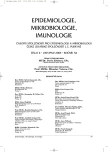-
Medical journals
- Career
Biological characteristics of Plesiomonas shigelloides strains of human and animal origin
Authors: A. Hoštacká 1; I. Čižnár 1; J. Rosinský 2
Authors‘ workplace: Slovenská zdravotnícka univerzita, Bratislava 1; NRC pre Vibrionaceae Regionálny úrad verejného zdravotníctva, Komárno 2
Published in: Epidemiol. Mikrobiol. Imunol. 54, 2005, č. 4, s. 148-153
Overview
We focused on serotyping and biological characteristics of Plesiomonas shigelloides strains potentially associated with virulence. Thirteen strains isolated from humans (H) and 14 strains of animal origin (A) were tested. The most frequent serotype among H strains was 040:H6 while 066:H3 predominated among A strains. All of the H strains and 92.8 % of A strains were hydrophobic. H isolates showed lower motility (30.1 mm) compared to A isolates (46.8 mm). As many as 76.9 % and 71.4 % of H and A strains, respectively, produced beta-hemolysis. Both H and A strains exhibited low biofilm production on a glass surface. No significant differences were found between H and A strains in lipase production and histidine decarboxylase production. The zones of bacterial growth inhibition in response to oxidative stress were on average 26.6 mm and 28.1 mm for H and A strains, respectively. None of the strains tested produced unsubstituted shortchain acyl homoserine lactones.
Our results showed that tested Plesiomonas shigelloides strains produced multiple potential virulence factors that may play a role in the pathogenesis of infections caused by this agent.Key words:
Plesiomonas shigelloides – serotypes – surface and enzymatic properties – oxidative stress.
Labels
Hygiene and epidemiology Medical virology Clinical microbiology
Article was published inEpidemiology, Microbiology, Immunology

2005 Issue 4
Most read in this issue- Mortality of Drug Users. Summary of Cohort Study Results.
- Biological characteristics of Plesiomonas shigelloides strains of human and animal origin
- Antibody Response to Ascaris lumbricoides among the Children Population in the Ústí Region
- Foams as Disinfectant Carriers
Login#ADS_BOTTOM_SCRIPTS#Forgotten passwordEnter the email address that you registered with. We will send you instructions on how to set a new password.
- Career

